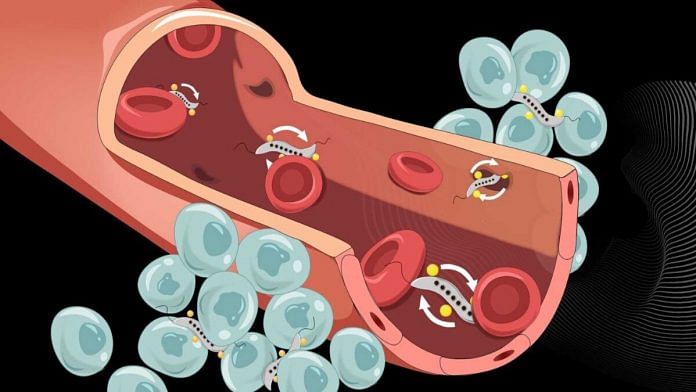New Delhi: Swiss researchers may have found a way to target cancerous tumours using the natural magnetic properties of some bacteria, thanks to the presence of iron oxide particles in them.
In an article published in the journal Science Robotics Wednesday, scientists from ETH Zurich, a public university, have proposed that the bacteria — whose movements can be controlled externally using their magnetic properties — can be used as ferries to deliver drugs on-site or to target a tumour using the natural ability of some organisms to target tumorous cells.
They used the bacteria Magnetospirillum magneticum because of its ability to respond to external magnetic fields. This means that the movements of the bacteria can be controlled by magnets from outside the body.
“Biohybrid bacteria–based microrobots are increasingly recognised as promising externally controllable vehicles for targeted cancer therapy. Magnetic fields in particular have been used as a safe means to transfer energy and direct their motion,” the researchers wrote in the journal.
So far, magnetic control strategies used in this context rely on poorly scalable magnetic field gradients, they added.
“We present a magnetic torque-driven control scheme for enhanced transport through biological barriers that complement the innate taxis toward tumor cores exhibited by a range of bacteria, shown for Magnetospirillum magneticum as a magnetically responsive model organism,” the researchers further said.
The lead author of the study is Simone Schürle, a professor of Responsive Biomedical Systems at ETH Zurich. Her team worked with cell cultures and with mice to demonstrate the feasibility of such an approach.
“We believe we can use our engineering approach to increase the efficacy of bacterial cancer therapy,” Schürle was quoted as saying in a statement issued by ETH Zurich on the findings. “We make use of the bacteria’s natural and autonomous locomotion as well. Once the bacteria have passed through the blood vessel wall and are in the tumour, they can independently migrate deep into its interior.”
That there are bacteria that respond to magnetic fields — called magnetotactic bacteria — is not a new discovery. Such bacteria were first discovered in the sea 45 years ago. The iron oxide crystals formed in the bacteria are because of the iron that these bacteria absorb from the seawater.
Because of their magnetic field, the bacteria align themselves against the earth’s magnetic axis in the same way that a magnetic needle does. Schürle and her team have been working on these bacteria for many years.
Also Read: Why women with stage 4 breast cancer deserve more than unrelatable pink ribbons
‘Propelling bacteria using a rotating magnetic field’
In their cell culture studies, the researchers attached liposomes — which are nanospheres of fat-like substances — to the bacteria.
Researchers tagged these liposomes with a fluorescent dye, which allowed them to demonstrate in a petri dish that the bacteria did indeed deliver their “cargo” inside the cancerous tissue, where it accumulated.
These liposomes could be filled with a drug for any future medical applications.
In their statement, the ETH Zurich researchers highlighted the superiority of the method used by the researchers in controlling the motion of the bacteria within the body.
“With the help of experiments and computer simulations, the ETH Zurich researchers were able to show that propelling the bacteria using a rotating magnetic field is effective for three reasons. First, propulsion via a rotating magnetic field is ten times more powerful than propulsion via a static magnetic field. The latter merely sets the direction and the bacteria have to move under their own power,” the researchers said.
The second and most critical reason is that bacteria driven by the rotating magnetic field are constantly in motion, travelling along the vascular wall, read their statement.
“This makes them more likely to encounter the gaps that briefly open between vessel wall cells compared to other propulsion types, in which the bacteria’s motion is less explorative. And third, unlike other methods, the bacteria do not need to be tracked via imaging. Once the magnetic field is positioned over the tumour, it does not need to be readjusted,” it added.
(Edited by Uttara Ramaswamy)
Also Read: Experimental drug shows success in advanced breast cancer patients, better than standard chemo






